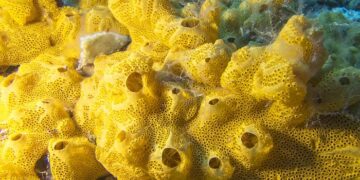Beneath the glistening surface of the ocean, amidst coral reefs and rocky substrates, lies one of the ocean’s most fascinating and ancient inhabitants: the sea sponge. Often overlooked due to their simple appearance, sea sponges are marvels of nature, possessing a multitude of secrets and remarkable characteristics that contribute significantly to marine ecosystems.
Ocean sea sponges, classified under the phylum Porifera, are among the oldest living organisms on Earth, with a lineage dating back over 600 million years. This makes them older than dinosaurs, older than flowering plants, and even older than many of the continents. Their long evolutionary history has equipped them with an extraordinary array of survival strategies, allowing them to thrive in various marine environments, from shallow coastal waters to the deepest ocean trenches.
Unlike most animals, sea sponges lack true tissues and organs. Their bodies are composed of a loose collection of cells, which form a porous structure capable of filtering vast amounts of water. A single sea sponge can filter thousands of liters of seawater every day, extracting plankton and organic particles for sustenance. This incredible filtration ability not only helps keep ocean waters clean but also makes sponges integral to nutrient cycling within their ecosystems.
Sea sponges come in an astonishing variety of shapes, sizes, and colors. From the vibrant, tubular sponge colonies found in tropical reefs to the massive, barrel-shaped sponges that can reach several feet in height, their diversity is astounding. Some species are soft and pliable, while others, like the glass sponge, have intricate silica skeletons that are as delicate as they are beautiful. This variety not only adds to the visual splendor of underwater landscapes but also indicates the sponge’s adaptability to different environmental conditions.
One of the most fascinating aspects of sea sponges in the ocean is their chemical arsenal. To deter predators and compete for space, sponges produce a wide range of bioactive compounds. These chemicals have garnered significant interest from the scientific and medical communities. Researchers have discovered that many sponge-derived compounds possess potent antibacterial, antiviral, and anticancer properties. For instance, the anti-tumor drug cytarabine, used in the treatment of leukemia and lymphoma, was originally derived from compounds found in sea sponges. The potential for discovering new, life-saving drugs from these humble organisms is immense, highlighting their importance not just to marine ecology but to human health as well.
Another remarkable feature of sea sponges is their regenerative capabilities. Sea sponges can regenerate from small fragments, allowing them to recover from injuries and even re-establish themselves after being nearly destroyed. This ability has fascinated scientists studying the processes of cell differentiation and tissue regeneration, offering insights that could one day inform regenerative medicine and tissue engineering.
Sea sponges also play a crucial role in marine symbiosis. Many sponges host a variety of microorganisms, including bacteria, algae, and fungi, within their tissues. These symbiotic relationships can be mutually beneficial. For example, photosynthetic algae living within sponges can provide them with nutrients produced via photosynthesis, while the sponge offers the algae a protected habitat. Such intricate relationships exemplify the complexity of marine ecosystems and the interconnectedness of life within them.
In addition to their ecological and medical significance, sea sponges have also influenced human culture. They have been used by humans for centuries, primarily for bathing and cleaning due to their absorbent and durable nature. In ancient Greece and Rome, sponges were highly valued, and even today, natural sea sponges are preferred by some for their sustainability and biodegradability compared to synthetic alternatives.
The world of sea sponges is one of ancient beauty, scientific intrigue, and ecological importance. Their simple yet effective design, combined with their vast diversity and the wealth of secrets they hold, makes them a subject of endless fascination. As we continue to explore and understand these enigmatic creatures, we uncover not only the wonders of the natural world but also potential solutions for some of the modern world’s greatest challenges. Sea sponges remind us that even the most unassuming organisms can hold the key to unlocking profound scientific and medical advancements, underscoring the importance of preserving our planet’s diverse and delicate marine ecosystems.


























